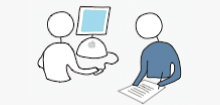Prototype
In an ideal world, all excellent ideas would work perfectly. The design process would be flawless.
Reality is different. Even good ideas require refinement. And, in the world of interaction design, that refinement comes from user feedback.
The sooner refinements occur, the less costly the improvements are. Prototypes are an effort to insure that not only are the basic structures and labels correct, the entire flow of the interaction is free from confusion.
Formative Testing
Essential refinement
Prototypes verify the value of good design.
- Interaction evaluations
- Refinement of functions, features, and designs
- Prototype refinements
These tests require time and energy. Well done early testing can provide a review of both the interface design and the scenarios of use that were defined as the most common paths through the system.
A decision to make this prototype as realistic as possible (high-fidelity) will enable a critique of the visual design as well as the flow of the interaction.
Various Methods
Paper prototypes can work well...
 |
Interactive prototyes, more complex to create, work quite well.
 |

